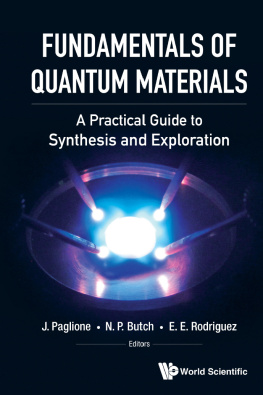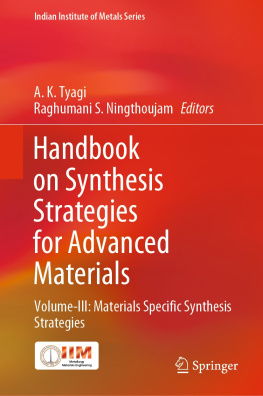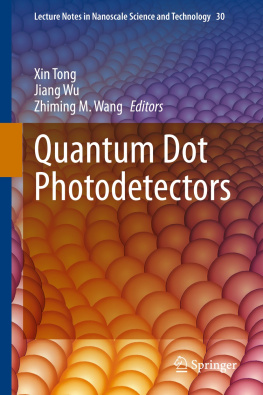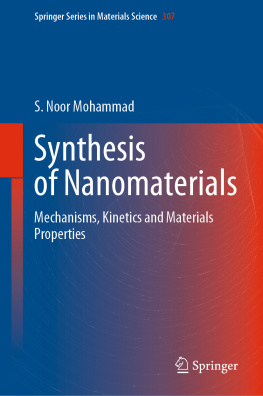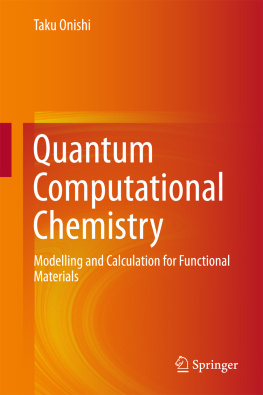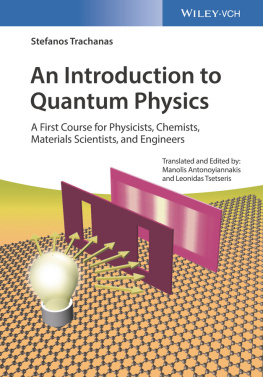Contents
Pagebreaks of the print version
FUNDAMENTALS OF
QUANTUM MATERIALS
A Practical Guide to Synthesis and Exploration
FUNDAMENTALS OF QUANTUM MATERIALS
A Practical Guide to Synthesis and Exploration
Editors
J. Paglione
University of Maryland, College Park, USA
N. P. Butch
National Institute of Standards and Technology, USA
E. E. Rodriguez
University of Maryland, College Park, USA

Published by
World Scientific Publishing Co. Pte. Ltd.
5 Toh Tuck Link, Singapore 596224
USA office: 27 Warren Street, Suite 401-402, Hackensack, NJ 07601
UK office: 57 Shelton Street, Covent Garden, London WC2H 9HE
Library of Congress Cataloging-in-Publication Data
Names: Paglione, Johnpierre, editor. | Butch, Nicholas P., editor. | Rodriguez, Efrain (Efrain E.), editor.
Title: Fundamentals of quantum materials : a practical guide to synthesis and exploration / [edited by] Johnpierre Paglione, Nicholas P. Butch, Efrain Rodriguez.
Description: New Jersey : World Scientific, [2020] | Includes bibliographical references and index.
Identifiers: LCCN 2020029888 | ISBN 9789811219368 (hardcover) | ISBN 9789811219375 (ebook for institutions) | ISBN 9789811219382 (ebook for individuals)
Subjects: LCSH: Superconductors--Materials. | Semiconductors--Materials. | Crystal growth. | Intermetallic compounds. | Quantum theory.
Classification: LCC TK7872.S8 F86 2020 | DDC 620.11--dc23
LC record available at https://lccn.loc.gov/2020029888
British Library Cataloguing-in-Publication Data
A catalogue record for this book is available from the British Library.
The publisher thanks American Chemical Society, John Wiley and Sons, and Elsevier for granting permissions to the figures reprinted in this volume.
Copyright 2021 by World Scientific Publishing Co. Pte. Ltd.
All rights reserved. This book, or parts thereof, may not be reproduced in any form or by any means, electronic or mechanical, including photocopying, recording or any information storage and retrieval system now known or to be invented, without written permission from the publisher.
For photocopying of material in this volume, please pay a copying fee through the Copyright Clearance Center, Inc., 222 Rosewood Drive, Danvers, MA 01923, USA. In this case permission to photocopy is not required from the publisher.
For any available supplementary material, please visit
https://www.worldscientific.com/worldscibooks/10.1142/11799#t=suppl
Typeset by Stallion Press
Email:
Printed in Singapore
Preface
This book presents a comprehensive overview of modern techniques and strategies for the synthesis of quantum materials. It is intended as a starting point for graduate students, a reference for practicing researchers, and a supply of inspiration for quantum materials projects. The chapters in this book are a product of the lectures taught at the Fundamentals of Quantum Materials (FQM) school held annually each January at the University of Maryland in College Park.
The first FQM school addressed an unmet need amongst quantum materials researchers, particularly physicists. Despite the existence of a long tradition of sophisticated and creative materials synthesis, sample growth has historically been considered a dark art, and a sense of broader community was missing among practitioners of quantum materials synthesis. Now, the school brings together the next generation of growers to learn techniques and pointers directly from senior scientists. The enthusiasm from both students and teachers has been both gratifying and invigorating. After hosting four schools, we can confidently say that physicists, chemists, and materials scientists experimentalists and theorists alike all want to know how to make a good sample.
The point of this book is to bring the content of the FQM school to the quantum materials community. We would like to thank everyone who has been involved. We are indebted to all the lecturers and presenters who have participated in the FQM schools and workshops. We are grateful to the students, who have shaped FQM into what it currently is, and without whom FQM would not exist. Finally, this book would not be possible without the commitment and expertise of the contributing authors, who have transformed their FQM lectures into an accessible manuscript. We hope readers will enjoy this essential guide and discover state-of-the-art techniques as they explore the Fundamentals of Quantum Materials.
Contents
Chapter 1
Introduction to the Synthesis of Quantum Materials: Some General Guidelines and A Few Tricks
Brian Sales
Materials Science and Technology Division Oak Ridge National Laboratory, Oak Ridge, TN 37831, USA
1.1.Introduction
This chapter is meant to provide a brief overview of how to prepare quantum materials, ideally as single crystals. The following chapters will discuss specific crystal growth methods for preparing quantum materials in more detail and with more examples. An obvious place to start is to ask exactly what is a quantum material? What are we trying to grow? This definition depends on whom you ask, but the definition that most people have adopted is the definition provided by the Department of Energy (DOE), a major funding source for the research. Quantum materials are defined as solids with exotic physical properties, arising from the quantum mechanical properties of their constituent electrons, that have great scientific and/or technological potential. This rather broad definition evolved from a DOE workshop aimed at identifying the basic research needs for Quantum Materials for Energy Relevant Technologies. The entire report is available [], who also pointed out that similar effects should occur for phonons.
Since much of the field of quantum materials is driven by condensed matter physicists, it is perhaps not surprising that most of the materials of interest are inorganic compounds or alloys. The careful preparation of single crystals of quantum materials suitable for the investigation of the exotic physics is the focus of this book. In this chapter, we will discuss the best practices that apply to the synthesis of any material, a brief description of the various types of crystal growth techniques, and then a few examples of crystals grown by different methods in our laboratory at the Oak Ridge National Laboratory.
1.2.Basics: Best Practices
1.2.1.Starting materials
You have identified a potentially interesting new quantum material AxByCz (where A, B, C are elements and x, y, z define the desired proportions) and you want to make it and study its properties. Where do you start? Almost all quantum materials are extremely sensitive to chemical impurities and defects. For example, the early attempts at preparing a topological insulator were unsuccessful because of the extreme requirements of composition and purity made the insulating bulk phase too electrically conducting to directly identify the topologically protected conducting surface layer. This is a problem in most semiconductors where the observed behavior is often due to unintentional doping or as Pauli noted the dirt ]. Strongly correlated materials, such as cuprate superconductors, have a similar sensitivity and small changes in composition can produce remarkable changes in properties. This means that your starting materials (A, B, C) should be as pure as possible. One common problem with purchasing chemicals from many vendors is that the purity stated on the bottle often excludes elements that may be present but were not specifically looked for by the vendor. For example, most vendors of rare-earth elements state a purity with respect to the presence of other metals, but nothing is said about oxygen, fluorine, carbon, chlorine or other elements. At low temperature small amounts of rare-earth oxide impurities can mask the intrinsic behavior of the quantum phase of interest. A more serious problem was encountered in our initial attempts to grow RuCl3 single crystals, a potential quantum spin liquid. The starting material from the vendor was stated as being 99.99% RuCl3, but upon careful analysis it only contained about 25% RuCl3 with the remaining 75% consisting of RuOCl2, Ru2OCl6, and Ru metal. In a couple of cases (over about 40 years of research), the bottle from the seller was completely mislabeled. In one case, zinc metal was labeled as antimony, and CeH2.5 was labeled as Ce metal powder. The Ce metal powder was reacted with As at elevated temperatures to form CeAs in a sealed silica tube. While the CeAs did form, the reaction also resulted in a silica tube with about 10 bars of H2 gas pressure. Upon carefully attempting to open the silica ampoule in a hood, the silica ampoule exploded from the pressure. Fortunately, no one was hurt, but this could have been serious and could have been avoided if we had initially

